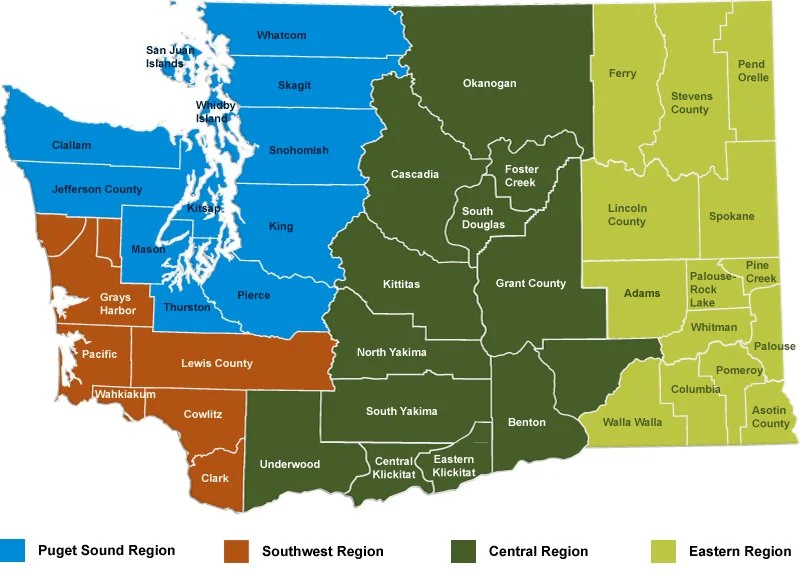Revitalizing Riparian Lands: A Vision of Hope and Action
Organizations around the Salish Sea are spearheading initiatives to rejuvenate riparian lands. This endeavor aims to restore ecological balance as well as inspire hope among our local communities. We have found that agroforestry in riparian areas is a beneficial land management strategy that offers a sustainable future.
A resilient solution
Agroforestry stands out as a highly effective solution for climate resilience, albeit with some challenges. The long maturation period of trees and crops can place farmers in a financial bind. Here, conservation districts and carbon trusts step in as crucial allies. We can bring landowners our extensive networks, technical support, and the tools they need to sustain the economic and ecological value of the land through carbon farming.
Jessa Clark, our Program Manager and a co-founder of Kulshan Carbon Trust, shared her excitement about expanding into the agroforestry space. “Much of KCT’s work thus far has focused on biochar and biochar-enhanced compost. Biochar works at the intersection of forests and fields.” As such, Jessa says, “Agroforestry is the ideal next step to expand our biochar work and foster a resilient landscape while aligning with our current efforts and collaborations.” She shares that upcoming projects will facilitate the supply chain for biochar and biochar-enhanced compost as applied in seedlings and during plantings. “This project presents an exciting opportunity to implement another collaborative natural climate solution,” Jessa shared.
Jessa concluded that as the organization moves into agroforestry, she is “excited to continue working with landowners and other local organizations, get out in the field, and see the science and practice of natural climate solutions evolve.”
The Role of Conservation Districts
Conservation works best when people who live and work in an area learn to care for their natural resources. Conservation Districts serve as community centers that unite people and assemble resources through voluntary, locally-driven efforts to achieve a healthier and greener future. They guide and support land stewards in managing the area where water meets land. Instead of imposing rules, these districts offer assistance to land owners on how to harmonize land uses, such as farming and forestry, with the protection of our natural environment.
In our area, the Whidbey Island, Skagit, Whatcom, and Snohomish Conservation Districts have all demonstrated the capacity to help landholders integrate restorative methods to maximize productivity and ecological health. For example, the Snohomish CD has been using agroforestry methods for several years, creating food forests that border riparian areas that draw inspiration from indigenous practices. They recently expanded their work with the help of a multi-district partnership with Skagit and Whidbey Island CDs in an initiative called Wet Feet Farming, which increases production on marginal farmland using practices such as alley cropping and food forests. This innovative work is crucial in restoring riparian health.
Backed by the Washington State Department of Agriculture (WSDA) and the Western Sustainable Agriculture Research and Education, these districts explore how agroforestry can enhance the value of wetlands, field edges, and farmland areas near water bodies. They are testing aronia berries, cider apples, and basketry willow on seven trial farms. Specialty crops like aronia and Malus fusca, a native crabapple, offer market opportunities and environmental resilience.
Skagit CD recently implemented a community-based social marketing campaign that addresses landowners' concerns about enrolling in natural resource programs. Their incentive pilot program completed 11 projects, restoring 3 miles of streams and planting 8,620 native trees and shrubs. Whatcom CD has collaborated with farmers since 1946 to enhance water and air quality around the Salish Sea. They do not explicitly employ agroforestry but implement other practices that promote ecosystem health. Whatcom CD has one of Washington state's most robust riparian restoration programs. They have planted over 1.5 million trees, restored 230 miles of streams, and improved over 3,000 acres of riparian lands.
See Conservation Districts at Work
A Vision for the Future
Our combined efforts to revitalize riparian lands through soil enrichment and agroforestry plantings represent a beacon of hope. We can create thriving ecosystems and resilient communities by integrating innovative land management strategies, fostering community involvement, and drawing on the wisdom of traditional practices. This initiative is more than a conservation effort; it is a movement toward a harmonious relationship with our environment.

